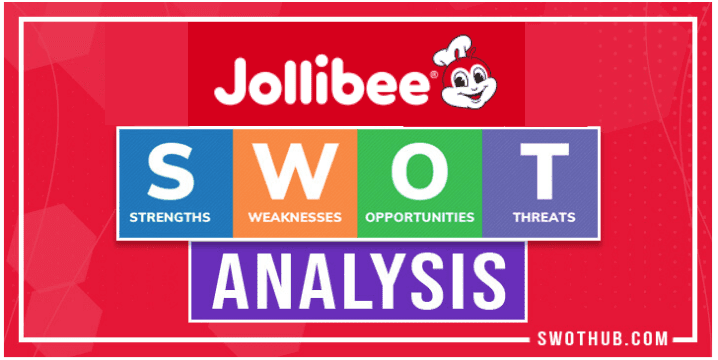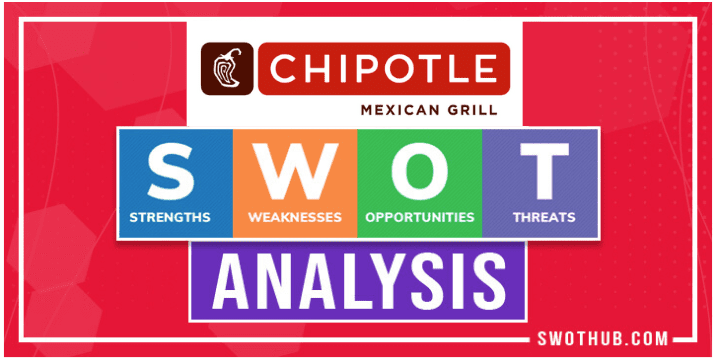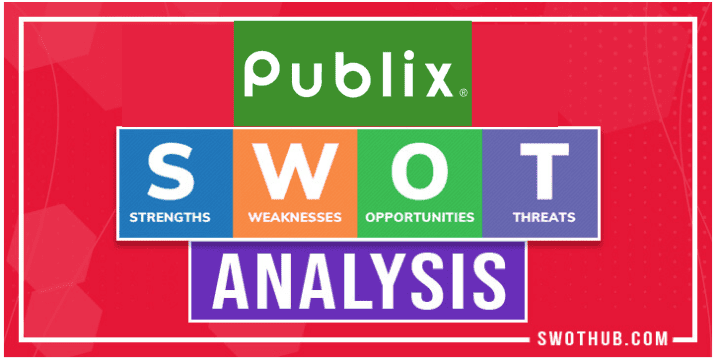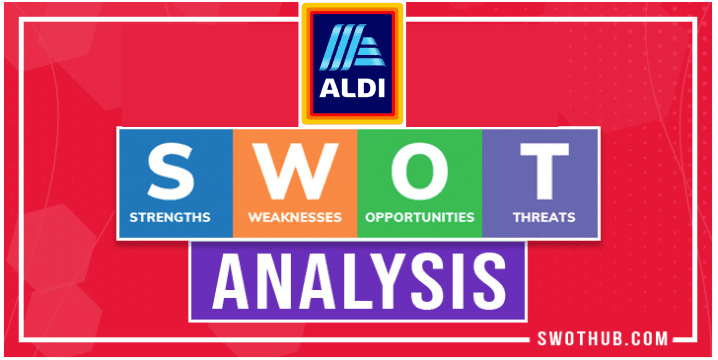The world of fast food restaurants has transformed the restaurant industry. From McDonald’s to Dunkin Donuts, ice cream, and fried chicken has made this Jollibee SWOT analysis a must! See how this ice-cream business turned fast-food chicken giant has made Jollibee competitors pay attention to this Phillipino mega house of a food brand.
Table of Contents
Jollibee Company Background
Under the trade name Jollibee, Jollibee Foods Corporation controls franchises and operates a network of fast-food restaurants. Jollibee Foods Corporation, also known as Jollibee Group or simply Jollibee—after its main fast food brand—is a multinational corporation with its headquarters in Pasig, Philippines. In 1975, Tony Tan Caktiong founded the Jollibee Group. He began everything with a small family company selling ice cream on the streets of Manila with the aid of his wife Grace, family, and in-laws. The family realized they could have hot dinners three years after they first started. They transformed the ice cream shops into the Jollibee fast food corporation that they are today.
JFC operated more than 6,300 shops as of September 2022. System-wide retail sales reached 210.9 billion yen. The largest fast-food chain in the Philippines, Jollibee, has more than 1,500 locations across 17 different nations. Jollibee is a market leader in the Philippines, holding a larger share of the domestic market than all other international fast food companies.
Jollibee serves great-tasting, high-quality, and affordable food products, including its superior-tasting Chickenjoy, mouthwatering Yumburger, and deliciously satisfying Jolly Spaghetti, among other delicious products, with strict adherence to the highest standards of food quality, service, and cleanliness. With over 270 international branches in the United States, Canada, Hong Kong, Macau, Brunei, Vietnam, Singapore, Malaysia, Saudi Arabia, the United Arab Emirates, Qatar, Oman, and Kuwait, Jollibee has started a vigorous global expansion strategy.
Jollibee Company SWOT Analysis – At a Glance
| Company | Jollibee Foods Corporation |
| Founders | Tony Tan |
| Year founded | 1978 |
| CEO | Ernesto Tanmantiong |
| Headquarters | Pasig, Philippines |
| Employees (2022) | 12,831 |
| Ticker Symbol | JBFCF |
| Annual Revenue (FY 2021) | PHP 153.5 Billion |
| Profit | Net income (FY 2021) | PHP 5.98 Billion |
Jollibee SWOT Analysis
SWOT analysis is a framework used to assess a company’s competitive situation and to create strategic planning. By taking Jollibee’s strengths, weaknesses of Jollibee threats of Jollibee’s as well as opportunities of Jollibee into account, we may better gain in-depth knowledge about Jollibee’s company. In this article, we’ll be taking a look at Jollibee’s SWOT framework to better understand its competitive position and potential for future growth. Read on to learn more about their Strengths, Weaknesses, Opportunities, and Threats!
Jollibee SWOT Analysis Strengths
A company’s areas of strength are those in which it performs above average or in a manner that differentiates it from its competitors. Jollibee’s strengths are outlined in this section of the Jollibee SWOT analysis.
Excellent meals: Jollibee does not simply sell any food. Because of its delicious and high-quality food, the business is able to attract loyal customers. The company continues to produce high-quality food with the aid of its unique recipe.
24/7 service: One of the few businesses that offer fast meal services around-the-clock is Jollibee. The company would stay open to serve its customers whether it was early in the morning or late at night. However, the business hires workers for a variety of shifts and continues switching them out.
Customer Loyalty: Over the years, Jollibee has gathered a sizable number of loyal customers. It is due to the services that the company has consistently provided over time. Because of the high standard of the food and service provided, the business has a very loyal customer base.
Powerful brand identity: Jollibee stands out in part due to its well-known brand identity. The company’s name and logo are both readily recognizable. Customers are therefore more likely to remember the goods and services that are being offered.
Best employers worldwide: Jollibee is ranked as one of the top employers in the world by the F&B Report. That is important for the business because it can keep its staff for a very long period. In exchange, management has more time to concentrate on business growth and less time to find new employees.
Jollibee SWOT Analysis Weaknesses
A company’s weaknesses are those that restrict its potential, reduce its competitiveness, and keep it from accomplishing its objectives. In this section of the SWOT of Jollibee, we’ll look at Jollibee’s weaknesses.
Lack of technology: Jollibee continues to prepare meals using outdated techniques, which are effective but time-consuming. The business does not use the most recent technologically automated culinary techniques. The company’s operations would become more effective.
Supply/Demand imbalance: Despite the large number of Jollibee branches countrywide, the high demand may cause a reduction in the food supply. Food items occasionally run out of supply because of demand.
Health awareness: People around the globe are paying closer attention to what they eat. As a result, some of the items on the Jollibee menu are classified as unhealthy, which can lead to obesity and other health problems. The company’s revenues are impacted as a result.
Expensive rates: Jollibee’s meal selection carries a hefty price tag. The bulk of customers lacks the financial resources necessary to purchase some of these foods. They ultimately shop at discount retailers.
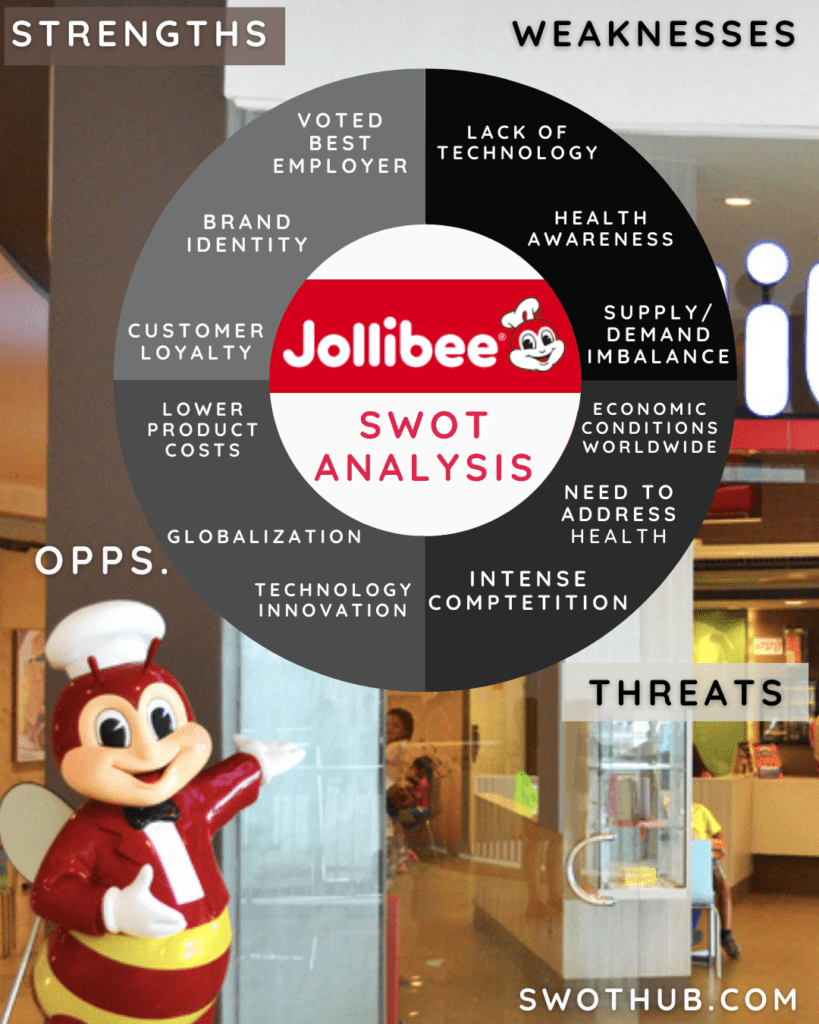
Jollibee SWOT Analysis Opportunities
The Jollibee Company exists in a world that is rich with possibilities. Some of the Jollibee opportunities will be examined in the following section of this Jollibee SWOT analysis:
Technological innovation: The popularity of internet food ordering and delivery services has grown. In order to debut its online food ordering platform and collaborate with delivery service providers, Jollibee should adopt the technology.
Globalization: As marketing raises consumer knowledge of Jollibee, entering new markets presents the opportunity to serve fresh clientele. As Jollibee boosts sales, the growth potential will help the company gain more recognition globally. Jollibee has added 314 additional locations around the world.
Technology Environment Change: The rise in machine learning and artificial intelligence is changing the technological environment in which Jollibee Foods competes. Christopher A. Bartlett claims that Jollibee Foods can use these advancements to boost productivity, cut expenses, and change processes.
Lowering product release cost: Lowering the price of new product releases through specialized social networks and independent retail partners. The new pattern of starting small before scaling up after a new product’s initial success can be used by Jollibee Foods ADR.
Threats for Jollibee SWOT Analysis
Threats put each company’s stability and profitability in danger. Jollibee’s threats which are crucial to consider will be covered in this article on the Jollibee SWOT analysis.
Economic disaster: All outdoor, social, and recreational activities have been put on hold due to the pandemic and the world financial disaster. Because of this, Jollibee’s yearly revenue and net income have decreased by 28.01% and 257.52%, respectively.
Healthy Diet Conscious: People are saying no to unhealthy fast food because they are becoming much more conscious of their diet and health. Such trends are seriously detrimental to Jollibee’s company.
Immense competition: Among Jollibee’s main competitors are McDonald’s, Starbucks, Burger King, Unilever, Chipotle, and Nestle. They operate internationally, enjoy a sizable market position, and enjoy devoted customers. Most importantly, they interact with the markets of their customers through a variety of marketing and promotional campaigns.
Growing Protectionism: Jollibee Foods should diversify its risk by operating in nations with various economic cycles in order to mitigate the risk associated with growing protectionism.
Jollibee Competitors Have a Big Reputation to Compete With
JFC acquired some of the Jollibee competitors in the fast food industry in the Philippines and overseas, including Chowking, Greenwich Pizza, Red Ribbon, and Mang Inasal, as a result of the success of its flagship brand.
Jollibee competitors and similar companies include:
- Burger King
- McDonald’s
- Subway
- Kentucky Fried Chicken (KFC)
- Etiler Marmaris
Jollibee faces some serious threats from strict government regulation, new companies that taking over the fast food market, and changes in consumer tastes and preferences are large considerations for Jollibee.
Jollibee Conclusion and Recommendations:
We have come to the conclusion that Jollibee is, in fact, the most well-known fast-food franchise brand in the world after carefully examining the Jollibee SWOT analysis of the company. The main difficulties include limited technology use, rising rivalry, lockdown, and social isolation. Jollibee should introduce an online food ordering service and broaden the range of its offerings. If Jollibee keeps adjusting and developing, Jollibee can retain its dominant position in the Philippines. Despite the competition, Jollibee stands out from everyone else in their nation thanks to its distinctive selling proposition.
- To face Jollibee competition in the market, Jollibee must introduce innovative technology in its processes. Jollibee should do product diversification to reduce exposure to market risk.
- Jollibee should expand its operations in adjacent markets to increase company profits. Also, the company should offer more products and increase the range of its offerings.
- Jollibee’s higher authorities have to be concerned about the supply and demand imbalance that the company currently facing.
Quick FAQ’s for Jollibee SWOT Analysis
-
What are Jollibee’s main strengths compared to its competitors?
Jollibee’s main strengths lie in its strong brand recognition and loyal customer base, particularly in the Philippines and among Filipino communities worldwide. The company’s menu offerings, specifically tailored to local tastes and preferences, give it a competitive edge over global fast-food chains. Jollibee’s aggressive expansion and well-established supply chain also contribute to its dominance in the fast-food market.
-
What weaknesses does Jollibee have in comparison to its competitors?
While Jollibee has a strong presence in its home market, it may face challenges in expanding internationally due to different cultural preferences and stiff competition from well-established global players. The company’s expansion strategy could be hampered by operational complexities and potential cultural adaptation issues.
-
How does Jollibee compare to its competitors in terms of opportunities?
Jollibee has several opportunities for growth, such as entering new international markets and tapping into the growing Filipino diaspora. The company can leverage its diverse and adaptable menu to cater to different regional tastes and expand its customer base.
-
What threats does Jollibee face when compared to its competitors?
Jollibee faces intense competition from global fast-food giants like McDonald’s, KFC, and Burger King, both in its home market and abroad. These competitors have well-established brands and significant financial resources, making it challenging for Jollibee to gain market share in some regions.
Do we have your taste buds watering? For more food giants, take a look at the Coca-Cola SWOT analysis and PepsiCo SWOT analysis here.

